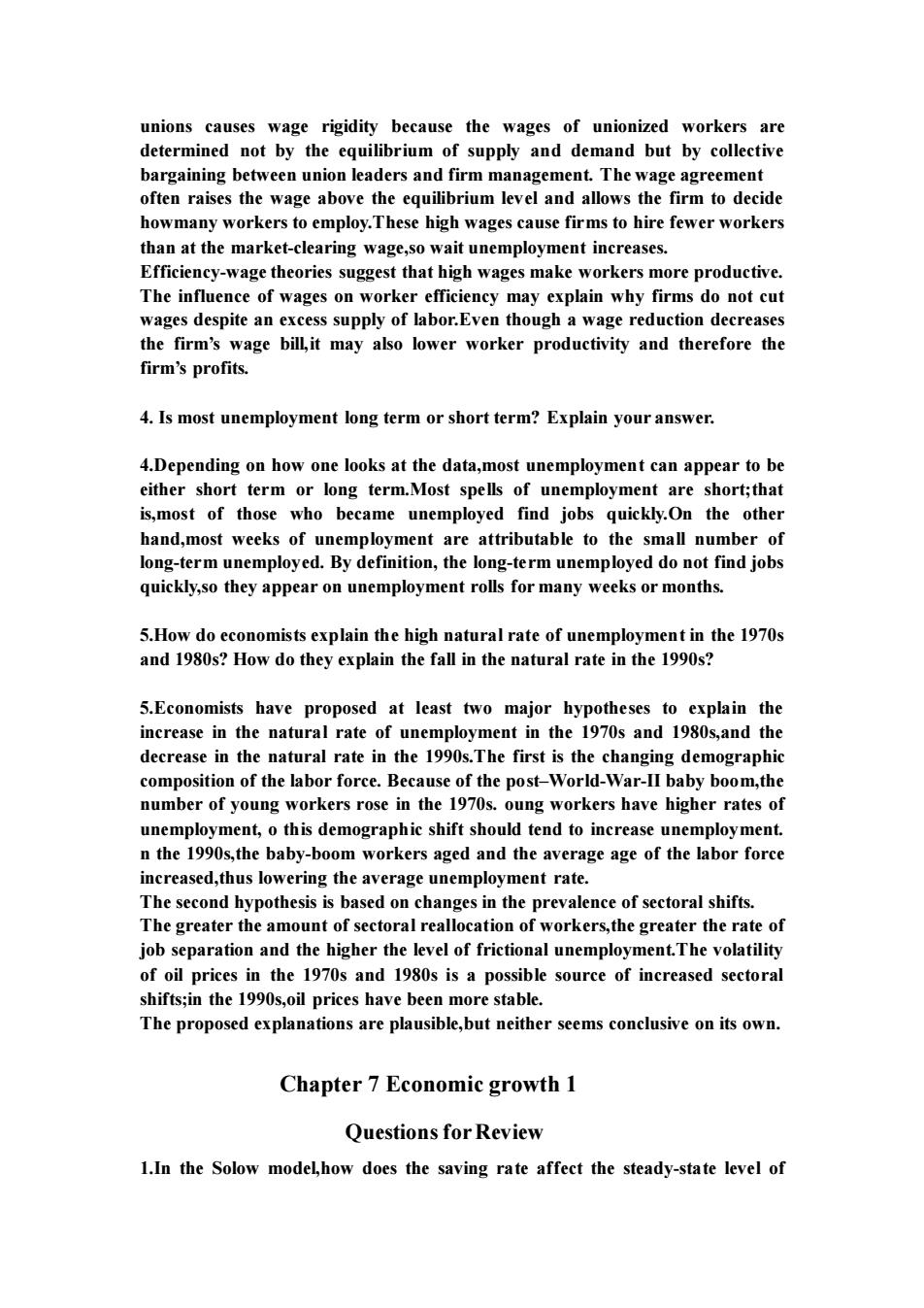正在加载图片...

union cause vage rigidity because the wages of unionized workers are determined not by the equilibrium of supply and demand but by collective bargaining between union leaders and firm management.The wage agreement often raises the wage above the equilibrium level and allows the firm to decide howmany workers to employ.These high wages cause firms to hire fewer workers than at the market-cearing wage.sowait unemployment increases. cy-wage theories suggest that high wages mak vorkers more productive The influence of wages on worker efficiency may explain why firms do not cut wages despite an excess supply of labor.Even though a wage reduction decreases the firm's wage bill,it may also lower worker productivity and therefore the firm's profits. 4.Is most unemployment long term or short term?Explain your answer 4.Depending on how one looks at the data,most unemployment can appear to be either short term or long term.Most spells of unemployment are short;that is,most of those who became unemployed find jobs uickly.On the other hand,most weeks of unemployment are attributable to nall numbe of long-term unemployed.By definition,the long-term unemployed do not find jobs quickly,so they appear on unemployment rolls for many weeks or months. 5.How do economists explain the high natural rate of unemployment in the 1970s and 1980s?Ho wdo they explain the fall in the natural rate in th 1990s 5.Economists have proposed at least two major hypotheses to explain the increase in the natural rate of unemployment in the 1970s and 1980s,and the decrease in the natural rate in the 1990s.The first is the changing demographic se of the pos -WorldWar-hah bo h r of young w orkers rose in the 1970s ung workers have higher rates o unemployment,o this demographic shift should tend to increase unemployment n the 1990s,the baby-boom workers aged and the average age of the labor force increased,thus lowering the average unemployment rate. The second hypothesis is based on change in the prevalence of seetoral shifts The greater unt of s ral rea orkers,the gre the rate or job separation and the higher the level of frictional unemployment.The volatility of oil prices in the 1970s and 1980s is a possible source of increased sectoral shifts;in the 1990s,oil prices have been more stable. The proposed explanations are plausible,but neither seems conclusive on its own Chapter 7 Economic growth 1 Ouestions for Review 1.In the Solow model,how does the saving rate affect the steady-state level ofunions causes wage rigidity because the wages of unionized workers are determined not by the equilibrium of supply and demand but by collective bargaining between union leaders and firm management. The wage agreement often raises the wage above the equilibrium level and allows the firm to decide howmany workers to employ.These high wages cause firms to hire fewer workers than at the market-clearing wage,so wait unemployment increases. Efficiency-wage theories suggest that high wages make workers more productive. The influence of wages on worker efficiency may explain why firms do not cut wages despite an excess supply of labor.Even though a wage reduction decreases the firm’s wage bill,it may also lower worker productivity and therefore the firm’s profits. 4. Is most unemployment long term or short term? Explain your answer. 4.Depending on how one looks at the data,most unemployment can appear to be either short term or long term.Most spells of unemployment are short;that is,most of those who became unemployed find jobs quickly.On the other hand,most weeks of unemployment are attributable to the small number of long-term unemployed. By definition, the long-term unemployed do not find jobs quickly,so they appear on unemployment rolls for many weeks or months. 5.How do economists explain the high natural rate of unemployment in the 1970s and 1980s? How do they explain the fall in the natural rate in the 1990s? 5.Economists have proposed at least two major hypotheses to explain the increase in the natural rate of unemployment in the 1970s and 1980s,and the decrease in the natural rate in the 1990s.The first is the changing demographic composition of the labor force. Because of the post–World-War-II baby boom,the number of young workers rose in the 1970s. oung workers have higher rates of unemployment, o this demographic shift should tend to increase unemployment. n the 1990s,the baby-boom workers aged and the average age of the labor force increased,thus lowering the average unemployment rate. The second hypothesis is based on changes in the prevalence of sectoral shifts. The greater the amount of sectoral reallocation of workers,the greater the rate of job separation and the higher the level of frictional unemployment.The volatility of oil prices in the 1970s and 1980s is a possible source of increased sectoral shifts;in the 1990s,oil prices have been more stable. The proposed explanations are plausible,but neither seems conclusive on its own. Chapter 7 Economic growth 1 Questions for Review 1.In the Solow model,how does the saving rate affect the steady-state level of